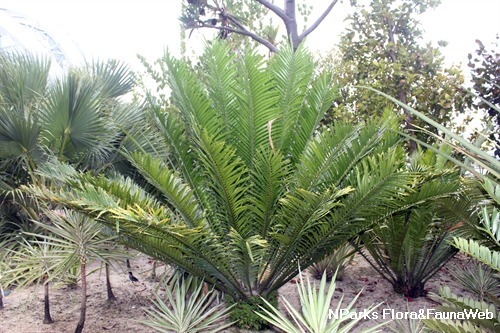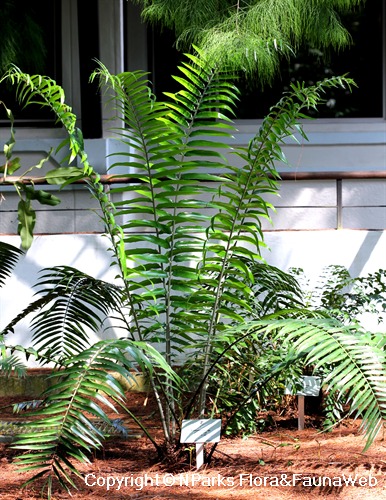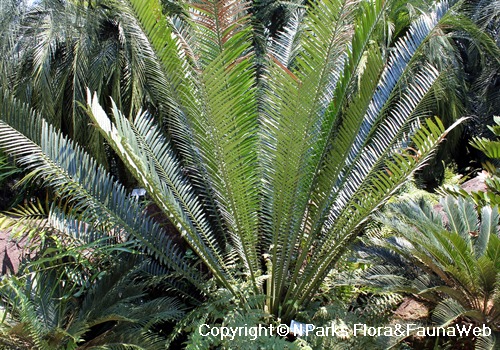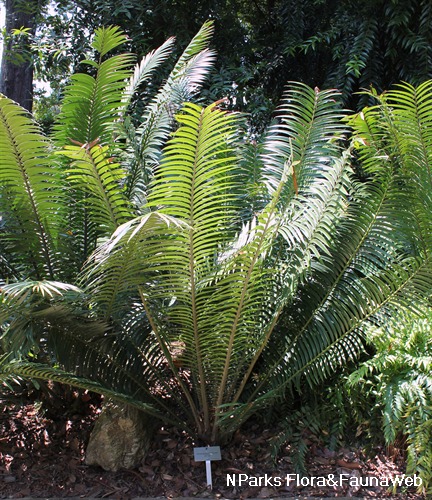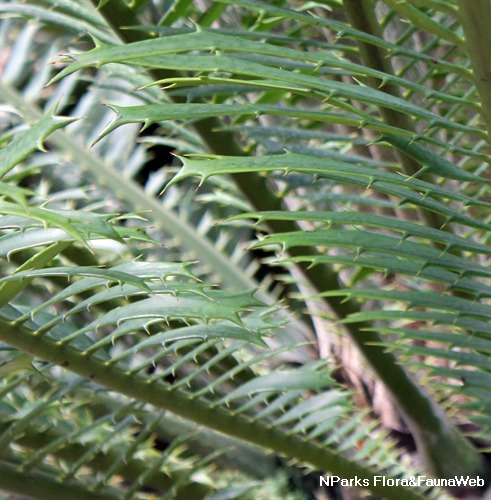
Back
Encephalartos ferox G.Bertol
| Family Name: | Zamiaceae |
| Synonyms: | Encephalartos kosiensis |
| Common Name: | Zuzuland Cycad, Tongaland Broodboom |
Name
Classifications and Characteristics
| Plant Division | Gymnosperms (Non-Flowering Seed Plants) (Cycad) |
|---|---|
| Plant Growth Form | Cycad |
| Lifespan (in Singapore) | Perennial |
| Mode of Nutrition | Autotrophic |
Biogeography
| Native Distribution | South Africa, Mozambique |
|---|---|
| Native Habitat | Terrestrial (Coastal Forest, Grassland / Savannah/ Scrubland) |
| Preferred Climate Zone | Tropical |
| Local Conservation Status | Non-native |
Description and Ethnobotany
| Growth Form | Cycad, stemless or sometimes has short stem, grows up to 1 m tall and 25 - 30 cm in diameter. |
|---|---|
| Foliage | Foliage 1 - 2 m long, dark green, very glossy texture, petiole straight with 1 - 6 prickles, collar at leaf-base is absent, slightly V-angled along the rachis and reduced to spines when nearing towards the leaf base. Leaflets often overlapping downwards, ovate in shape, measures up to 200 x 70 mm, margin flat or incurved with 1 - 3 teeth on each side. |
| Flowers | Both male and female cones are borne on separate plants. Male cones 1 - 3 (older ones can have as many as 10 cones), fusiform (spindle-shaped), measures 40 - 50 cm long and 8 - 10 cm in diameter, bright orange - red or scarlet. Female cones 1 - 5, ovoid shaped, measures 25 - 50 cm long and 20 - 40 cm in diameter, orange - red. |
| Fruit | Female cone bears around 500 seeds which are oblong in shape, 4.5 - 5 cm long and 1.5 - 2 cm in diameter, bright red to black . |
| Habitat | Common at evergreen coastal forest, to dense shrubland, and grassland areas. |
| Cultivation | Grows well in frost free area, prefers shady conditions of well-drained soil. |
| Etymology | The genus Encephalartos means bread of the head, which refers to the bread-like food made from the plant caudex's pulp. The specific epithet ferox means very prickly. |
| Ethnobotanical Uses | Edible Plant Parts : Edible Stems Food (Fruit or Vegetable): The Afrikaans in the past used the plant stems as source of food. |
Landscaping Features
| Landscaping | Suitable as a feature landscaping plant due to its foliage that gives tropical impression. |
|---|---|
| Desirable Plant Features | Ornamental Foliage |
| Landscape Uses | Coastal, Container Planting |
| Usage Hazard - Cons | Spines/Thorns - Leaf |
Plant Care and Propagation
| Light Preference | Full Sun |
|---|---|
| Water Preference | Moderate Water |
| Plant Growth Rate | Moderate |
| Rootzone Tolerance | Well-Drained Soils |
| Propagation Method | Seed, Sucker, Division |
Foliar
| Foliage Retention | Evergreen |
|---|---|
| Mature Foliage Colour(s) | Green |
| Mature Foliage Texture(s) | Glossy / Shiny |
| Prominent Young Flush Colour(s) | Green |
| Young Flush Texture(s) | Glossy / Shiny |
| Foliar Modification | Spine (marginal) |
| Foliar Attachment to Stem | Petiolate |
Floral (Angiosperm)
| Flower & Plant Sexuality | Unisexual Flowers |
| Flower Colour(s) | Orange, Red |
|---|
Image Repository
Others
| Master ID | 32775 |
|---|---|
| Species ID | 7187 |
| Flora Disclaimer | The information in this website has been compiled from reliable sources, such as reference works on medicinal plants. It is not a substitute for medical advice or treatment and NParks does not purport to provide any medical advice. Readers should always consult his/her physician before using or consuming a plant for medicinal purposes. |

